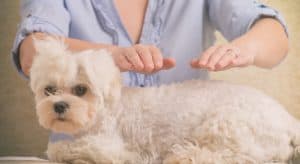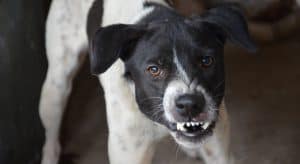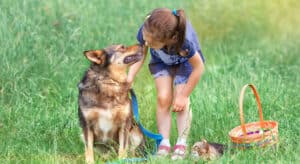There are several reasons why your dog may feel aggressive towards a baby. If your dog is dominant, fearful or predatory this could cause a threat to a baby, toddler, or even a young child.
Dominant Dog
For example, a dog who is dominant would pose a threat to a child around toddler age. This would be due to the dog perceiving the child as a competitor.
Fearful Dog
A fearful dog may be aggressive if they felt they could not escape the advances of an out-of-control child.
High Prey Drive
Finally, but rarely, there are dogs with predatory characteristics that may pose a threat to newborn infants. A dog who possesses a high prey drive desires to find pursue, and catch prey.
.
Prevention & Helpful Tips
Prevention is key to working with this potential aggression towards babies. As soon as you know you are about to have a baby, you should start a ‘baby friendly’ behavior modification program with your dog.
Here are some Prevention Tips.
- Understand your dog, including his breed characteristics and personality. Look to see if he may fall into any of the three categories dominant, fearful or predatory.
- Control your child. Especially during that toddler age. Do not allow the child to compete with or create a threat to your dog in any way.
- Never leave an infant or child of any age alone with your dog. No matter your dog’s personality.
- Institute a dominance management program if you feel your dog is dominant. Do this as soon as possible.
For fearful dogs, you can find a behavioral counselor to assist you with a technique called systematic desensitization to help reduce your dog’s fear. No matter what your dog’s personality, sharpen up his obedience skills. If your dog has any existing behavior problems, it makes sense to get those dealt with now before the baby arrives.
Here are some general tips for Before and After the baby arrives.
.
Tips Before The Baby Arrives
Make the Novel Normal
- Make changes to your dog’s environment and routine early. For example, if you know your dogs walking or feeding times will change once the baby arrives, then change them now!!!
- Start walking your dog beside the baby stroller that you will be using with the baby. Get him used to this now instead of waiting until the baby arrives.
- Play a tape of a crying baby in order to desensitize your dog to this unusual noise.
- Let your dog investigate baby items like clothing, rattles, rocking chairs, and anything that will be a normal part of life once the baby arrives.
- Have an infant doll for the dog to investigate. You can simulate having your baby at home by rocking her in the rocking chair, cradling her, etc. Let your dog investigate.
.
General Tips After the New Baby Arrives
- Introduce your dog to the family’s new edition very slowly and don’t make a big deal out of it.
- Place your dog on a leash. Easier said than done, but do not ignore your dog when the baby is around. Everybody making a fuss over the baby and not the dog could create a canine rivalry.
- Never leave your dog alone with the baby. We cannot emphasize this enough
- Review canine body language and vocalization section…. Get to know the signs of dominance, fear, and aggression. For example, if a dog’s tail is low tucked between his legs, he’s afraid This would be the wrong time to let your baby interact with him.
- One last piece of advice is that you do not want your dog to feel as though he has ‘lost out’ as a result of having a baby in the house. You want your dog to feel it is a beneficial addition to the pack! Dogs can develop jealousy and even rivalry with any new member of the pack Whether they are a baby or a dog. Prevention and preparation, while you are waiting for your new arrival, will give a happy result that will last a lifetime.
.
Further information
For more information on dog training techniques and how to deal with problem dog behavior (like accustoming your dog to children), check out Secrets to Dog Training. It’s the complete manual for dog ownership and is designed to fast-track your dog’s learning.







